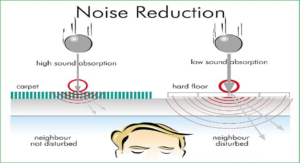Education
Sound Absorption Education
 Acoustics Specification:
Acoustics Specification:
When properly selected, carpet is an outstanding sound absorptive material as it absorbs airborne noise as efficiently as many specialized acoustical materials. As soon as the carpet is installed over a hard-surface floor the impact sound transmission to rooms below is an obvious acoustical advantage. No other acoustical material performs the dual role of a floor covering and versatile acoustical aid. Understanding the acoustical values of carpet constructions and the combinations of specific carpet cushions is important.
Sound absorption:
A noise reduction coefficient (NRC) is used in grading the effectiveness of the material employed for sound control. Sound absorption coefficients, the fraction of incident sound energy that is absorbed by the material, vary strongly with frequency.
Small samples can be measured by the impedance tube method, while larger specimens can be measured by the reverberation room method. Reverberation room coefficients are usually provided as a single number, NRC. This number is the average of the coefficients at 250, 500, 1000, and 2000 Hz (from low- to high-pitched sounds).
Sound transmission:
Transmission through walls, floors, and other barriers is much greater for low-frequency sounds than for high-frequency sounds. Sound transmission is measured between two reverberation rooms for at least 16 standard frequency bands.
For convenience in comparison of different constructions, the sound transmission class (STC) rating condenses sound transmission information into a single number according to ASTM E-413. STC is fairly accurate for human speech. For low-frequency sounds, such as a motor, fan, or even music with strong bass, the perceived sound may be greater than that indicated by STC.
